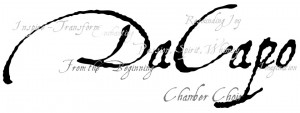
There’s no getting around it, rescheduling a concert is a hassle for all involved. Those who turned up at St John the Evangelist Anglican Church in Kitchener Wednesday evening know that sometimes, it is worth it. Initially a victim of an early march snowstorm, take two of this concert presented by Waterloo’s Da Capo Chamber Choir and The Guelph Chamber Choir was entitled Two: A Second Glance.
The idea behind the program is ingenious. Since most sacred music is conceived to be functional, that is used in liturgy, it is not usual for the same texts to be used over and over again. The Eucharist, Requiem Mass, StabatMater, Nunc dimittus and many others are standard texts hundreds of composers set during the 1300 years sung liturgy has existed. A Second Glance consisted of two examples of three familiar texts set in contrasting styles.
The first pairing was a setting of Psalm 117 Praise the Lord, all ye nations by JS Bach and Swedish composer Sven-David Sandström. The GCC’sreading of Bach’s motet suffered badly from sagging pitch and under-rehearsal. Using the chamber organ setting was the right choice stylistically,but practically speaking, the choir would have benefited enormously from being able hear the accompaniment. The choir is capable of better but on this occasion the effect was rather like thirty people singing simultaneously rather than together.
After a short deconstruction by Da Capo director Leonard Enns, the choir dove into Sandström’s re-imagining of Bach’s piece. Da Capo specializes in unaccompanied music of the 20th century and it showed. Their sound is clean and pure and they negotiate complex rhythm and large jumps withease. Sopranos Cher Farrell and Julie Surian made repeated excursions intothe stratosphere seemingly without effort and were spot on every time.
When David Heard, the text for the next pairing, is about King David’s griefafter hearing his son Absalom, who was fighting a literal battle against him,was dead. The first setting, by medieval English composer Thomas Weelkesis still in regular rotation as an anthem in the Anglican church. Althoughpolyphonic like the Bach motet it is much less frilly. Happily, the GCC wasable to return to form and gave a strong performance.
American composer Eric Whitacre’s setting of the text is not a re-inventionof Weelkes but rather a distinct composition written in response to the deathof a friend’s son. From the first notes the listener is drawn in to a world ofpalpable anguish, anger and pain. Da Capo gave a performance that wasprofoundly moving despite having to contend with consistently disjunctmelodic lines and nearly 10 minutes of pianissimo singing. Farrell andSurian provided the icing on the cake, soaring above the rest of the groupwith perfect intonation and remarkable sound.
The last pairing was the text to the Agnus Dei, part of the Eucharist. Thechoirs joined forces for Samuel Barber’s setting, more commonlyrecognized as the Adagio for Strings from his String Quartet Op.11. One of the challenges of singing this piece is that its phrases are enormously long.On the whole, the choir did a good job of staggering breaths so the overallline wasn’t disrupted. Another difficult aspect is the range it requires. In thisregard, the choir was less successful with an exposed soprano leap up to a Bnatural falling significantly short.
Where Barber pleads intensely for God’s mercy and peace, Canadian composer Rupert Lang is much gentler and more self-assured in his request.Some nice solo work by Christopher Everett complemented the lush soundof the combined choirs.




